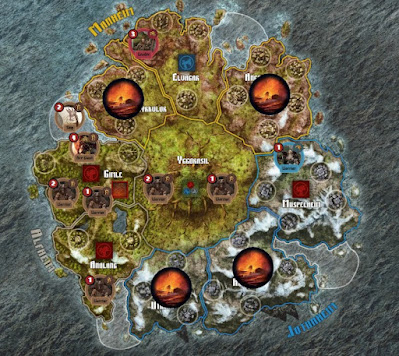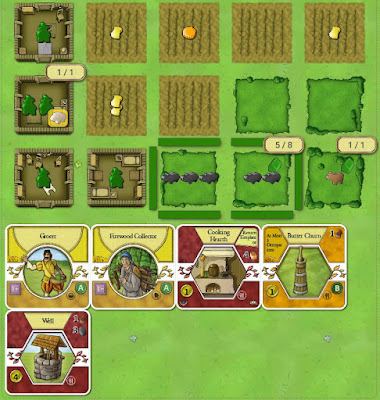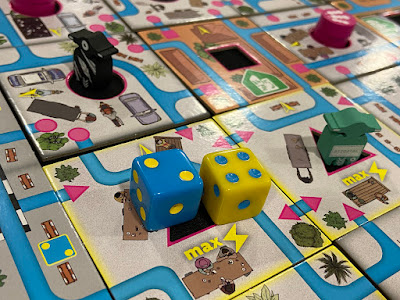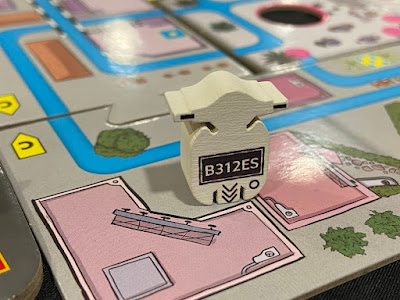The Game
I wrote about Innovation 15 years ago, in 2010. That was when the first edition of the game was released. This is a slightly older game, so some newer hobbyists may not have tried it, or may not have heard of it. Since I'm a big fan, I'll give a quick overview. Having played the game many more times compared to when I first wrote about it, I now have a different appreciation of the game.
Innovation is a card game about human civilisation and inventions, ideas and technologies. Every card in the game is unique and has a different power. The cards are divided into 10 ages (11 in Innovation Ultimate). You start from the ancient age and gradually progress through the eras, possibly advancing to the near future. The basic actions in the game are very simple. You draw cards, you play cards, you activate powers on your cards. When you play a card before you, it becomes part of your empire. Cards come in five colours, and you can have up to five stacks of cards in your empire, each for one colour. Every card has four icons, and there are six types of icons in the game. You will be regularly comparing icons with your opponents. When you have more icons of a particular type than your opponent, you will be able to attack them using some card powers. Also when they use a power on their card, you also get to use it. You piggyback on their actions because you are stronger in that particular icon type.
One important concept in the game is splaying. This is how you can increase the number of icons in your empire. In the beginning of the game, cards of the same colour are stacked together. When you gain the ability to splay some of your card stacks, you will reveal some icons on the non-top cards. Depending on whether you can splay your stacks left, right or up, you will expose a different number of icons.
Some cards let you score points. When you do so, you claim some cards face-down and tuck them under the left edge of your player board. The age number on these cards now become point values. You don't win by having the most points. In fact the points you score are not secure. Your opponents may rob you of your points. Whenever you reach certain thresholds of points, you can claim achievements. It is the achievements which help you win the game. You need a certain number of them to declare victory. Collecting points is one way of claiming achievements. The other way is completing specific missions, which are quite difficult.
Innovation is a crazy game. There are many powerful cards in the game. Some cards don't look like much, but under certain situations they suddenly become deadly. This is a game with huge swings. The game situation can shift quickly. A trailing player can become the biggest threat just because of one new card being played. There is certainly some luck and randomness in the game. There is always a sense of hope. You never know - the next card you draw may just be the killer card you need to turn things around. It's a lot of fun trying to figure out how to make good use of the combination of cards you have in play and in hand. This is a game with variety and surprises.
Innovation Ultimate
The Ultimate edition (2025) is released 15 years after the first edition. Over the years there have been four different expansions released for Innovation. The game is perfectly fine without any expansion. Only if you have played a lot of it you might want to have even more variety. The Ultimate edition includes all four expansions and adds one new expansion - Unseen.
One change introduced is Age 11. I'm not sure whether that's necessary. In my previous games of the older Innovation, I rarely even get to Age 9. The rulebook recommends arranging the card stacks in a circle like an analogue clock, placing the row of achievements at the 12 o'clock position. I find that cumbersome. I just place my stacks in two neat rows.
The card backs now have new art. It's okay for me. The old art worked just fine for me too, and I don't tire of it. Different expansions use card backs in different colours. Beige is the base game. Grey is the Unseen expansion.
Younger daughter Chen Rui and I tried one game with the latest Unseen expansion. The first thing I noticed was that they had changed the base game too. My base game is the first edition. Even before Innovation Ultimate, the base game had been updated several times, up to the fourth edition. So my copy is pretty outdated. I haven't paid attention to what have been changed. I'm so used to my first edition that this latest edition is a little unsettling.
The Unseen expansion is about weird stuff in history like magic, superstitions, legends and witchcraft. There are some powers which remove whole stacks of cards from the game. That's shocking! When this happens, it means we will advance more quickly to the higher ages. That's a good thing I guess. In the past, I rarely even get to Age 8.
The Unseen expansion has its own set of special achievements.
Card backs of the Unseen expansion (left) and the base game (right)
One new-to-me concept in Innovation Ultimate is the Junk keyword, which means permanently removing cards from the game. This Medicine card above junks an achievement. This is the first time I see achievements being removed. This doesn't happen in the first edition of Innovation.
This card April Fool's Day is from the Unseen expansion. When I first read it, I thought this was an easy way to score an achievement. Upon rereading it, I realised you can only achieve if you have no hand cards and also no score cards at all. If by Age 4 I still have no score cards, I probably deserve some pity and thus this achievement.
The Knights Templar is also a card from the Unseen expansion. This is an attack card and it can force your opponent to unsplay their cards. This is such a nasty thing to do! I did it to Chen Rui several times. Thankfully she hasn't disowned me yet.
2-player game
In the past when I played Innovation with two or more expansions, I thought it was a little bit too much. Too many things to juggle at the same time, and it felt tedious. Now in the Ultimate edition, the rulebook says play with just one expansion at a time. In addition to the base game the expansions have also been adjusted. They are tweaked to be more independent of one another. When these expansions were previously released one after another, the later expansions used mechanisms introduced in the earlier expansions. This means if I want to skip some expansions and play with only a later one, I still need to learn the new rules introduced in the earlier expansions. In the Ultimate edition, this has been greatly reduced, so that from the base game you can choose to proceed to any of the expansions. There are still some rules which are relevant to all expansions, but this is much more manageable than before.
Innovation is an important game in the world of boardgames. It is like Hamlet. If you like English literature, you have to read it. Innovation is an amazing achievement. It is a game with crazy swings and much replayability. It should always be on this kind of list - the top 100 games that every gamer must play.

















































